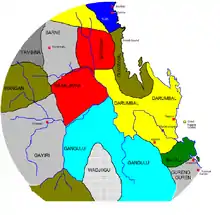
The Gayiri, people, also spelt or known as Kairi, Kararya, Kari, Khararya and Kaira, Bimurraburra, Gahrarja, Gara Gara, Ara Ara, and Kara Kara,[1] are an Aboriginal Australian people of the state of Queensland.
Country
According to an estimation made by Norman Tindale, the Kairi held sway over some 5,900 square miles (15,000 km2) of territory, from the Great Dividing Range south of Springsure[lower-alpha 1] north to Capella. The Drummond Range formed their western frontier, while their eastern boundaries were drawn by the Comet and upper Mackenzie (Nogoa) rivers.[3]
Social organisation
The Kairi were divided into hordes, the name of at least one of which is known.
Alternative names
- Khararya. (kara is their word for "no".)
- Bimurraburra.[3]
Cullin-la-ringo massacre
Gayiri men were involved in the Cullin-la-ringo massacre, in which 19 settlers were killed as retribution after Gayiri men had been murdered after being falsely accused of stealing cattle. Settlers and native police killed around 370 Gayiri people in reprisal killings.[4]
Notes
- ↑ Middleton and Noble state they were some 25 miles north of present-day Springsure.[2]
Citations
- ↑ "E44: Gayiri". AIATSIS Collection: AUSTLANG. 26 July 2019. Retrieved 31 July 2020.
- ↑ Middleton & Noble 1887, p. 90.
- 1 2 3 Tindale 1974, p. 173.
- ↑ Jackson, Russell (17 September 2021). "Research discovery suggests AFL pioneer Tom Wills participated in massacres of Indigenous people". ABC News. Australian Broadcasting Corporation. Retrieved 3 October 2021.
Sources
- Middleton, T.; Noble, E. Irving (1887). "Nogoa" (PDF). In Curr, Edward Micklethwaite (ed.). The Australian race: its origin, languages, customs, place of landing in Australia and the routes by which it spread itself over the continent. Vol. 3. Melbourne: J. Ferres. pp. 90–95.
- Tindale, Norman Barnett (1974). "Kairi (QLD)". Aboriginal Tribes of Australia: Their Terrain, Environmental Controls, Distribution, Limits, and Proper Names. Australian National University Press.